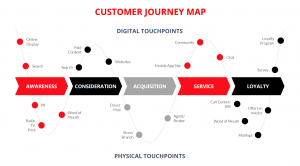Creating your own customer journey stages is a great way to personalize your business to your customers and ensure that they always have the best possible experience. Planning ahead will help you create effective marketing strategies, while staying true to your brand’s voice and values. By following few simple steps, you’ll be well on your way to creating a successful customer experience!
What is a Customer Journey?
A customer journey is the sum total of experiences a customer has with your company. It starts with the first time they hear about you and ends when they’re no longer a customer. Every interaction, both online and offline, contributes to their perception of your brand. That’s why it’s important to create a customer journey stages for your business and map out your future marketing strategies.
The first step is to understand your customers. Who are they? What are their needs and wants? Once you have a better understanding of who they are, you can start creating buyer personas. A buyer persona is a fictional, generalized representation of your ideal customer. It includes demographic information like age, gender, and income level, as well as psychographic data like interests and values.
How to Create your Customer Journey
Creating a customer journey stages for your business is essential to success. As a business owner, you have to think about what your customers want and need, and then plan your marketing strategies accordingly. Here are the steps on how to create your customer journey:
- Identify your customer
Creating a customer journey map is a great way to better understand your customers. By identifying your customer, you can create a more targeted and effective marketing strategy. When selling a product or service, it is important to identify your customer. This means understanding their needs and desires in order to create a product or service that appeals to them. It’s also
- Understand their needs
In order to understand customer needs, it is important to first know what the customer wants. Understanding their needs is essential to providing them with the best possible experience. This can be done by asking questions and getting feedback. This will help businesses cater to their specific needs and create a customer-oriented experience.
- Customer Journey Map
When creating a customer journey map, it’s important to consider all of the different touchpoints a customer might have with your company. This includes interactions with your website, marketing materials, customer service etc. and what steps they go through to reach a desired outcome.
To map out the customer journey, start by creating a storyboard that illustrates the typical customer’s experience. In addition to outlining the steps customers take, be sure to identify any potential pain points or areas where they might encounter roadblocks.
Once you have a good understanding of the customer journey map, you can begin to design solutions that make the process easier and more efficient. By addressing potential problems and optimizing the customer experience, you’ll not only improve satisfaction levels but also increase sales and loyalty.
- Create Touchpoints and Content for Each Stage
Touchpoints are the places where customers interact with your company, and content is what you put in those touchpoints. It’s important to think about both the overall journey and the individual steps within it, because each step is an opportunity to delight customers and encourage them to keep moving forward.
Your touchpoints should be designed to provide a smooth, seamless experience that helps customers move from one step to the next. Content should be informative and helpful, but it should also be entertaining and engaging so that customers will want to read it. You’ll need to tailor your content to different channels, such as websites, social media, email marketing, and printed materials etc.
- Analyze and Adjust as Needed
As a business, it is important to understand the customer journey and how to best service your customers. It is also important to be able to analyze and adjust as needed. This means being able to take in feedback, both good and bad, and make changes accordingly. Sometimes this may mean making small tweaks, while other times it may mean a complete overhaul of your business model. The key is being willing to listen to your customers and make the changes needed to keep them happy.
- Keep Track of Results
By keeping track of your customer’s journey, you can see what works and what doesn’t, and make adjustments accordingly.
One way to keep track of your customer journey is to create a diagram or map. This will help you visualize the different stages that your customer goes through, as well as the interactions they have with your company. Another way to track results is through data tracking. This can help you see how effective different marketing campaigns are, and which channels are driving the most traffic and conversions.
Whatever method you choose, it’s important to be systematic in your approach and constantly analyze the data. This will help you improve your customer experience and increase sales.
Why Do You Need a Customer Journey?
The modern customer is more informed and in control than ever before. They can easily compare products and services online, and they expect a personalized experience that meets their specific needs.
This is where the customer journey comes in. A well-designed customer journey map can help businesses understand how customers interact with their brand, identify opportunities for improvement, and create a more personalized experience for each individual customer.
There are many different ways to design a customer journey map, but the key is to include all the steps a customer takes from initial contact to final purchase (or abandonment). It’s also important to track all the channels customers use to interact with your brand, including website, social media, phone calls, etc.
The goal is to create a complete picture of how your customers interact with your business so you can make changes where necessary and improve your bottom line.
The Different Stages of a Customer Journey
When a customer interacts with a company, they go through different stages of their customer journey. The first stage is when the customer is aware of the company and what it does. They may see an ad or hear about the company from a friend. The second stage is when the customer is interested in the company’s product or service. They may do research on the company or visit its website. The third stage is when the customer decides to buy from the company. This can be influenced by many factors, such as price and quality of the product. The fourth stage is when the customer uses the product or service. They may have questions or problems that need to be solved. The fifth stage is when the customer becomes a returning customer. They may recommend the company to others or buy more products from it.

Planning Future Marketing Strategies
Marketing is always evolving, and businesses must continually plan new strategies to stay ahead of the competition. One key element of successful marketing is understanding the customer journey. This involves knowing what steps customers take when making a purchase decision, and tailoring your marketing efforts accordingly.
There are many different ways to reach customers, and it’s important to consider all of them when developing a marketing plan. If you are targeting potential customers who are not yet aware of your product or service, you will need to invest in online advertising and create engaging content that will capture their attention. If you are targeting customers who are ready to buy, you will need to focus on lead generation and creating a positive customer experience that will encourage them to return.
Traditional methods such as TV advertising and print ads are still valuable, but they’re no longer effective enough on their own. To be successful, businesses must also use digital marketing channels such as social media, search engine optimization (SEO), and email marketing. Another important factor to consider is the way customers interact with brands online.
Conclusion
In conclusion, creating a customer journey is a great way to map out your marketing strategies and figure out what steps you need to take to reach your target market. By understanding your customer’s needs and desires, you can create a plan that will not only bring in new customers, but keep them coming back for more. So, if you’re looking to improve your business, start by creating a customer journey map and see where it takes you.
Talk to us today! Reach us on work@ravianmedia.com






